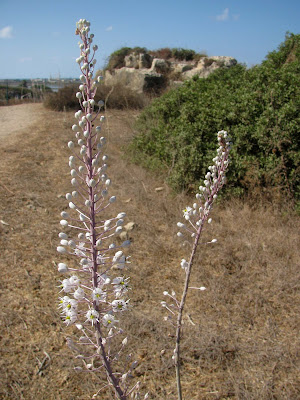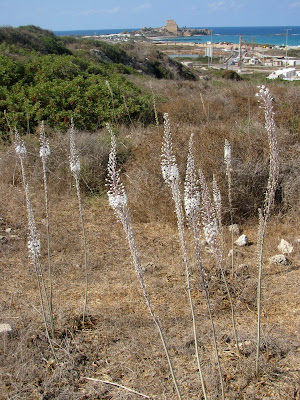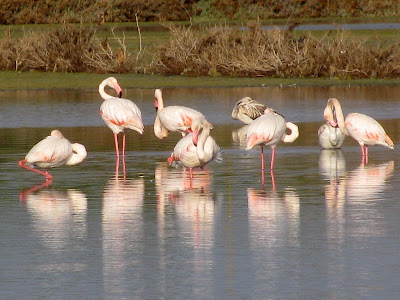Château Pèlerin was not demolished by the Mamluks, as was their normal practice after capturing a Crusader fortification. It in fact remained intact for several hundred years, until suffering damage in an earthquake in 1837.
Aaron Aaronsohn (a Jewish agronomist, botanist and head of the NILI espionage group) established an agricultural station at Atlit in 1911. Château Pèlerin became an important observation point used by the NILI spy team in transferring data to the British during World War I. The NILI spies would make contact with the British who would sail by. The British would send a small boat in to shore in the middle of the night to give gold coins to support the Jewish effort and in return would get detailed plans of Turkish movements. These interactions with the British Intelligence played a part in General Allenby's successful defeat of the Turkish army in Israel in 1917.
Today the fortress is an Israeli Navy base and the headquarters of the Shayetet 13 naval commando unit. As a result, it is within a closed military zone and we were only able to view it from the beach.
Today the fortress is an Israeli Navy base and the headquarters of the Shayetet 13 naval commando unit. As a result, it is within a closed military zone and we were only able to view it from the beach.
We were however able to explore the large Crusader cemetery south of the fortress. The cemetery dates from the 12-13th century and has more than 1,700 graves, above and below. Knights, pilgrims, residents and professionals working on the fortress were buried there and some gravestones are decorated with stylized patterns of crosses and icons indicating the status and profession of the deceased.
I read that the best place to view Château Pèlerin was from the viewing terrace at Khirbet Karta, so that was our next stop. We parked in the Limor picnic area, named after a member of the Genio family who founded the salt works in Atlit, and walked up to the viewing point which was once a British Mandatory water tower. The views of the salt ponds full of flamingos and other migrating birds, the Mediterranean Sea and Mount Carmel were wonderful. To the north we could see the ruins of Château Pèlerin and Le Destroit.Le Destroit was a Crusader fortress which preceded Château Pèlerin. It was built sometime in the 1100s to protect Château Pèlerin and to secure the convoys that traveled along the sea. It was demolished by the Crusaders themselves about a century after its founding. The reason for this was the Crusaders' desire to avoid a Mamluk siege on the tiny fortress, which count not withstand it.
The Crusaders called Le Destroit Districtum and in French Destroit. The Hebrew name, Khirbet Karta, is related to the Hebrew churvan, meaning desolation or a destroyed place. Karta, which is taken from Aramaic and used today in modern Hebrew, means city, which this place does not really seem to have been.
Excavations inside the fortress and the surrounding area revealed water cisterns and the remains of clay pipes used to collect rainwater. To the north of the fortress are the remains of horse stables, below. There is a row of cavities, which were probably used for tying the animals. On the southern side of the stables, there is a row of sockets in the wall that were likely used to support the beams of a wooden roof that covered the place.
Further along we saw a guard booth hewn from sandstone and on the vertical, eastern quarried wall of the fortress, a large ancient inscription which has been cut into the rock. The letters are Phoenician script, probably the first two signs of the name of the Phoenician settlement.Khirbet Karta is one of those sites that draws large groups of flower lovers every year, to view hundreds of blooming sea squills in one spot. Sea squills bloom at the end of August and September and into October each year, depending on the area and temperature. The blooming occurs earlier in the colder areas and later in the warm places. It just so happened that we visited Khirbet Karta back in October, when the flowers were in full bloom!
The sea squill is a common plant that stands out in the landscape. It is special due to its lifecycle and structure: its onions, its leaves, its flowers and its toxic materials. In November it grows leaves which last through the winter and early spring. By April the leaves wilt and all above-ground parts of the plant die. At the end of the summer a single flowering white pillar without any green leaves rises for just a few weeks. This can grow up to two meters high. The flowering begins from the bottom of the high flower pillar and every day another group of about 30 flowers opens above the previous ones, and the flowers that opened the day before wilt. The flower opens at night and remains open for approximately 18 hours.
The fact that the plant produces leaves in the spring and flowers in the fall is a way to survive the Mediterranean climate because the summers here are so hot and dry.
The sea squill is a common plant that stands out in the landscape. It is special due to its lifecycle and structure: its onions, its leaves, its flowers and its toxic materials. In November it grows leaves which last through the winter and early spring. By April the leaves wilt and all above-ground parts of the plant die. At the end of the summer a single flowering white pillar without any green leaves rises for just a few weeks. This can grow up to two meters high. The flowering begins from the bottom of the high flower pillar and every day another group of about 30 flowers opens above the previous ones, and the flowers that opened the day before wilt. The flower opens at night and remains open for approximately 18 hours.
In Hebrew the sea squill is called Hatzav, from the root meaning "to chisel" because this hardy flower chisels itself into rock. The Jewish sages mentioned that Joshua used the sea squill to mark the borders of the Land of Israel. The plant's toxicity deterred people from digging up the bulbs to move the boundaries. The Egyptians referred to the sea squill as Ein Sit, the god who resists the sun, because it only blooms in the autumn.
The sea squill is one of the rare poisonous plants in Israel and one should not touch the bulbs without wearing gloves. It is related to the onion and, just as onions causes your eyes to burn when you chop them, sea squill leaves contain burning needle-like crystals. The flower was often used to protect graves in Arab cemeteries so that predators like wolves, jackals and hyenas wouldn't dig up the corpses. The flowers are thought of as messengers and are known as basl el maytin (bulb of the dead).
A folk saying across the Middle East and North Africa goes "The sea squill blooms and the summer ends". The sea squill may only bloom for a short period but it is one of the most beloved plants here in Israel. Children are taught to look out for it and the plant even has its own song, כמו חצב, written by Naomi Shemer, one of Israel's leading songwriters.* This post has been shared on My Corner of the World, Little Things Thursday and Wordless Wednesday (on Tuesday).












































































